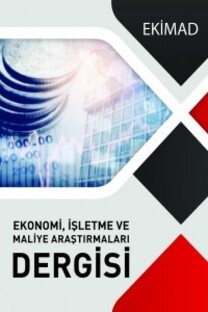Havayolu Şirketlerinde Yan Gelir: Havayolu Yöneticilerinin ve Yolcu Tercihlerinin Karşılaştırılması
Havayolu iş modelleri, yan gelir, ek hizmetler
___
- Amadeus. (2017). Merchandising '17 : Trends in Airline Ancillaries. Dublin: Accenture.
- Atay, D. (2015, 06). Why Should Airlines Introduce New Ancillary Charges as a Revenue Maximization Tool? Yüksek Lisans Tezi. İstanbul: İstanbul Teknik Üniversitesi.
- Bachwich, A. R., & Wittman, M. D. (2017). The emergence and effects of the ultra-low cost carrier (ULCC) business model in the U.S. airline industry. Journal of Air Transport Management(62), 155-164.
- Bockelie, A., & Belobaba, P. (2017). Incorporating ancillary services in airline passenger choice models. Journal of Revenue and Pricing Management, 16, 6, 553–568.
- CarTrawler. (2017). Airline ancillary revenue projected to be $82.2 billion worldwide in 2017. Dublin: Ideaworks.
- Chadha, A. (2016). Game Theory For Managers: Doing Business in a Strategic World. Delhi: PHI Learning Private Limited.
- Chung, J. Y., & Petrick, J. F. (2012). Price Fairness of Airline Ancillary Fees: An Attributional Approach. Journal of Travel Research, 168-181.
- Conrady, R., & Buck, M. (2012). Trends and Issues in Global Tourism. Berlin: Springer.
- Doğruer, M. C. (2015, 05). Increasing Ancillary Revenues And A Proposal for Turkish Airlines. Yüksek Lisans Tezi. İstanbul: İstanbul Teknik Üniversitesi.
- Emirates. (2018, 01 02). Emirates. Ortak Kod Paylaşımlı Uçuşlar. Code Share Nedir?: https://www.emirates.com/tr/turkish/help/faq/193940/what-is-codeshare adresinden alındı
- Garrow, L. A., Hotle, S., & Mumbower, S. (2012). Assessment of product debundling trends in the US airline industry: Customer service and public policy implications. Transportation Research Part A(46), 255–268.
- Hao, E. (2014). Ancillary Revenues in the Airline Industry: Impacts on Revenue Management and Distribution Systems. Boston: Massachusetts Institute of Technology.
- Holloway, S. (2012). Straight and Level: Practical Airline Economics (3rd Edition b.). Ashgate Publishing.IATA. (2017). Economic Performance of Airline Industry. Montreal: IATA.
- Ideaworks. (2017). Global Statistics of a la Carte Revenue. Shorewood: Ideaworks.
- IHLG. (2017). Aviation Benefits 2017 - Industry High Level Group Report. Montreal: ICAO.
- Johnson, G., Whittington, R., Scholes, K., Angwin, A., & Regnér, P. (2014). Exploring Strategy Text & Cases (10th Edition b.). Pearson Publishing.
- Klophaus, R., Conrady, R., & Fichert, F. (2012). Low cost carriers going hybrid: Evidence from Europe. Journal of Air Transport Management, 54-58.
- Maja, O. B., & Ruzica, S. B. (2018). European Air Transport Market Under Influence of Cooperative Arrangements. International Conference of Traffic and Transport Engineering (s. 38-43). Belgrade: City Net Scientifics Research Center.
- O'Connel, J. F., & Williams, G. (2012). Air Transport in the 21st Century: Key Strategic Developments. New York: Ashgate Publishing.
- O'Connel, J. F., Smith, & Warnock, D. (2013). An investigation into traveler preferences and acceptance levels of airline ancillary revenues. Journal of Air Transport Management(33), 12-21.
- Oliveira, A. V., & Huse, C. (2009). Localized competitive advantage and price reactions to entry: Full-service vs. low-cost airlines in recently liberalized emerging markets. Transportation Research Part E, 307-320.
- Önen, V. (2016). Geleneksel Havayolları ile Düşük Maliyetli Taşıyıcılar Arasındaki Stratejik Yönetim ve Pazarlama Karması Farklılıklarının İçerik Analizi, THY-Pegasus Karşılaştırması. International Journal of Academic Value Studies, 63-94.
- Pearce, B. (2017). Economic Performance of the Airline Industry Report . London: IATA.
- Peksatıcı, Ö. (2016). Ancillary Revenue Opportunities in Turkish Domestic Aviation Market. International Journal of Economics, Commerce and Management, 4(1), 175-206.
- Pine, B. J., & Gilmore, H. J. (1999). The Experience Economy: Work Is Theatre & Every Business a Stage. Boston: Harvard Business School Press.
- Porter, M. E. (1980). Competitive Strategy: Techniques for Analyzing Industries and Competitors. New York: The Free Press.
- Tanrısevdi, A., & Çulha, O. (2010). Düşük Fiyatlı Havayolu Taşımacılığı (Dfht) Sektörünün. Elektronik Sosyal Bilimler Dergisi, 65-100.
- Thomas, J., & Catlin, B. (2014). Executive Insights - Aviation Insights Review (AIR): The Future of Airline Business Models - Which Will Win? Boston: L.E.K. Consulting LLC.
- Tuzovic, S., Simpson, M. C., Kuppelwieser, V. G., & Finsterwalder, J. (2014). From ‘free’ to fee: Acceptability of airline ancillary fees and the effects on customer behavior. Journal ofRetailingandConsumerServices(21), 98-107.
- Vinod, B., & Moore, K. (2009). Promoting branded fare families and ancillary services: Merchandising and its impacts on the travel value chain. Journal of Revenue and Pricing Management(8), 174–186.
- Wittmer, A., & Rowley, E. (2014). Customer value of purchasable supplementary services: The case of a European full network carrier’s economy class. Journal of Air Transport Management(34), 17-23.
- Woodruff, R. (1997). Customer value: the next source for competitive advantage. Journal of the Academy of Marketing Science, 2(25), 139-153.
- Xia, L., Monroe, K. B., & Cox, J. L. (2004). The Price Is Unfair! A Conceptual Framework of Price Fairness Perceptions. Journal of Marketing, 4(68), 1-15.
- Yurtsever, A. S. (2015, 06 12). Air Transport Management. Yüksek Lisans Tezi. İstanbul: İstanbul Teknik Üniversitesi.
- Yayın Aralığı: Yılda 3 Sayı
- Başlangıç: 2018
- Yayıncı: İrfan ERSİN
Bağımsız Denetim Yaptırılmamasının Mali ve Hukuki Sonuçları
Havayolu Şirketlerinde Yan Gelir: Havayolu Yöneticilerinin ve Yolcu Tercihlerinin Karşılaştırılması
Emine Müge ÇETİNER, Mustafa Fatih GÜNEŞ, Ahmet Erdal PEKER
Nisa Nur MUSLUHİTTİNOGLU, Zafer ADIGÜZEL
Finansal ve Ekonomik Kararlılık Sağlayabilmek İçin Rekabetçi Piyasalarda Banka Faiz Oranının Rolü
